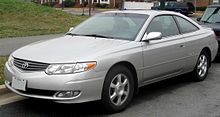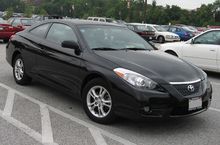Toyota Camry Solara
| Toyota Camry Solara | |
|---|---|
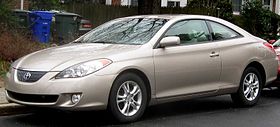 | |
| Overview | |
| Manufacturer | Toyota |
| Also called | Toyota Solara |
| Production | 1998–2008[1] |
| Model years | 1999–2008[2][3][4] |
| Body and chassis | |
| Class | Mid-size car |
| Body style |
|
| Layout | Front-engine, front-wheel-drive |
| Related | |
| Chronology | |
| Predecessor | Toyota Camry coupé (XV10) Toyota Supra (US) |
The Toyota Camry Solara, popularly known as the Toyota Solara, is a mid-size coupé/convertible built by Toyota. The Camry Solara is mechanically based on the Toyota Camry and effectively replaced the discontinued Camry Coupé (XV10); however, in contrast with its predecessor's conservative design, the Camry Solara was designed with a greater emphasis on sportiness, with more rakish styling, and uprated suspension and engine tuning intended to provide a sportier feel.[5] The coupe was launched in late 1998 as a 1999 model.[1] In 2000, the convertible was introduced, effectively replacing the Celica convertible in Toyota's North American lineup.[6]
The second-generation Camry Solara debuted in 2003 for model year 2004,[7] initially offered as a coupe; the second-generation convertible was introduced in the spring of 2004 as a 2005 model.[1] Coupe production ended in mid-2008 due to faltering sales.[8] Despite official statements that the convertible might be sold until 2010 if demand was sufficient, production was suspended in December 2008 and never resumed.[8][9][10]
All models of the Camry Solara only feature the "Solara" portion of the name on exterior emblems, and the "Camry" portion of the name is rarely used when referring to the car in general.[citation needed]
Contents
First generation (XV20; 1998–2003)[edit]
| First generation and Mark V (XV20) | |
|---|---|
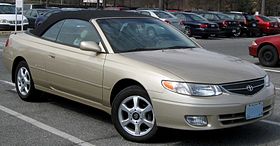 | |
| Overview | |
| Production | June 1998–June 2003 |
| Model years | 1999–2003 |
| Assembly | Canada: Cambridge, Ontario (TMMC) |
| Designer | Warren J. Crain (1995)[11] |
| Powertrain | |
| Engine | |
| Transmission | |
| Dimensions | |
| Wheelbase | 105.1 in (2,670 mm) |
| Length |
|
| Width | 71.1 in (1,806 mm) |
| Height |
|
This section needs additional citations for verification. (April 2018) (Learn how and when to remove this template message) |
Created to appeal to a demographic of more sport-minded drivers than those who prefer the Toyota Camry sedan, the Camry Solara aspired to blend "sporty" looks and style with spacious practicality. Prior to the production of the Camry Solara, the 2-door version of the Toyota Camry was simply known as the Camry Coupe. It was added to the third generation Camry lineup in 1993 for model year 1994 to compete with the Honda Accord and other cars in its class. However, due to it never being nearly as popular as the 4-door sedan of the Camry, the Camry Coupe was dropped in 1996 when the sedan was redesigned for model year 1997. A distinct successor went into development in the mid-1990s, resulting a winning design entry in 1995 from Warren J. Crain of Calty Design and Research. After design approval, production development ran from 1995 to the first half of 1998. Patents were filed at the Japan Patent Office on January 18, 1996 under 1020408 and November 14, 1996 at the United States Patent Office USPTO under D407350.
The first generation Camry Solara went on sale in the third quarter of 1998 as a 1999 model to replace the Camry Coupe. It was based on the mechanical platform of the previous generation Toyota Camry and was built at the TMMC facilities in Cambridge, Ontario, Canada. This model featured a 4-cylinder 5S-FE 2.2 L engine with 135 net HP (101 kW), and 147 lb⋅ft (199 N⋅m) of torque at 4400 rpm, and a V6 1MZ-FE 3.0 L engine with 200 net HP at 5,200 rpm (149 kW), and 214 lb⋅ft (290 N⋅m) of torque at 4,400 rpm with a 0 to 60 mph (97 km/h) time of 7.1 seconds,[citation needed] both of which are identical engines to the 4th generation Camry, but slightly revamped to have a small gain in power (2 hp and 6 hp (4 kW), respectively).
- 2.2L 5S-FE engine with 135 hp (101 kW), and 147 lb⋅ft (199 N⋅m) of torque at 4400 rpm (SXV20)
- 3.0L 1MZ-FE V6 engine with 200 hp at 5,200 rpm (149 kW), and 214 lb⋅ft (290 N⋅m) of torque at 4,400 rpm with a 0 to 60 mph of 7.1 seconds (MCV20)
The Toyota Camry Solara is also the first vehicle in the Toyota lineup, after their 1997 partnership agreement to feature a JBL premium stereo option, which all models came with a single-slot in-dash CD player and cassette deck. The SE models come standard with 15-inch steel wheels and hubcaps, upgradable to 15-inch alloy wheels. The Sports Package also adds a retuned suspension, perforated leather-wrapped steering wheel, perforated eight-way power-adjustable leather seats, an upgrade to 16-inch alloy wheels, retuned steering, minor trim changes and a rear lip spoiler.
In 2000, the SE and SLE convertibles were added to the lineup; these cars were built as semi-finished coupes, shipped to an American Sunroof Company (ASC) facility where the roofs were removed and convertible tops installed, and were then shipped back to Toyota for painting and final assembly.[6][12] Claiming that the car's basic structure was designed for this treatment, Toyota made no suspension or structural changes from the coupe.[6] Also in 2000, all JBL head units were upgraded to an in-dash 6-disc CD changer with a cassette deck.[citation needed]
Minor model update (2001–2003)[edit]
The Camry Solara was facelifted in September 2001 for the 2002 model year, receiving changes to the grille pattern, taillights, headlights that now featured a 4-bulb system instead of 2, a chrome logo on the steering wheel (instead of an embossed pattern), and smaller fog lights. The trunk was now openable by remote and the wood trim changed from Oxford Burlwood to Mustard Wood. New packages and options were also offered and include heated leather seats, an Appearance Package that featured a 3-spoke steering wheel, leather-wrapped shift knob, black pearl emblems, and a different center cap on the wheels.
Mechanically, the 2.2-liter four-cylinder engine was replaced with the same 2.4-liter four-cylinder engine offered on the redesigned 2002 Camry, the 2AZ-FE. This new engine was chosen because it featured the same gas mileage as the previous engine, except it offered more power and the addition of VVT-i, a technology that improved performance and reduced emissions. This new engine featured 157 hp (117 kW) net at 5,600 rpm, and 162 lb⋅ft (220 N⋅m) of torque at 4,000 rpm, up 22 hp (16 kW) from the previous model.[13]
Second generation (XV30; 2003–2008)[edit]
| Second generation (XV30) | |
|---|---|
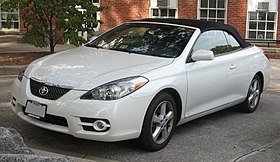 | |
| Overview | |
| Production | July 2003[14] – 2008[8][10] |
| Model years | 2004–2008[3] |
| Assembly | United States: Georgetown, Kentucky (TMMK) |
| Designer | Noboyuki Kato (2001)[15] |
| Body and chassis | |
| Platform | Toyota K platform |
| Powertrain | |
| Engine | |
| Transmission |
|
| Dimensions | |
| Wheelbase | 107.1 in (2,720 mm) |
| Length | 192.5 in (4,890 mm) |
| Width | 71.5 in (1,816 mm) |
| Height |
|
The second generation of the Camry Solara was completely redesigned (design approval in 2001; JPO patent number 1218292) and introduced to the public in August 2003[1] for the 2004 model year[16] and featured a curvier body, with the option of adding XM radio and/or a navigation system.[7] Based on the platform of the 2002 Camry sedan,[17] the Gen 2 body is heavier than the Gen 1.5 body. The 4-cylinder is a carryover of the first mid generation's engine, and the larger available engine was the new 3.3 L V6 rated at 225 net hp at 5,600 rpm (168 kW) and 240 lb⋅ft (325 N⋅m) of torque at 3,600 rpm. It has a 0-60 mph (97 km/h) time of 6.9 seconds[citation needed]and a quarter-mile time of 15.50 seconds at 93.50 mph (150.47 km/h). With the four-cylinder engine you could choose a five-speed manual or four-speed automatic transmission, while the V6 was matched to only a five-speed automatic transmission equipped with a sequential automatic, also known as a Multi-Mode Transmission (MMT). Both engines now feature Toyota's VVT-i technology.
The Solara moved to Toyota Motor Manufacturing Kentucky for the second generation model. Production started in July 2003 for the coupe and February 2004 for the convertible.[14] The convertible was offered only with the 3.3 liter V-6 coupled to the 5-speed automatic transmission.[1][18] Rather than being adapted from the coupe like the first-generation car—which had been criticized for poor structural rigidity[19]—Toyota claimed that the second-generation convertible was specifically designed and built as such, with a more rigid body structure for decreased levels of noise and vibration.[18][19]
In late 2005 for model year 2006, the four-speed automatic was dropped on the Solara in favor of the five-speed MMT automatic transmission.[20]
In June 2006 a restyled 2007 Solara went on sale. On the SE, rear LED taillights had been added, spoilers are now standard on all trim lines, with the reverse lights moved into the bumpers. The rear end "SOLARA" badging is now printed in bold uppercase letters as opposed to the previous cursive print. The SE Sport became available with its own unique spoiler; noticeable changes on the front end were smaller fog lights, new badging, a slightly redesigned set of headlights and grille. Interior changes include Optitron gauges, blue backlighting in the rest of the car's controls, a new steering wheel design that is somewhat similar to the recently revised Camry SE's steering wheel, revised shifter, MP3 and WMA CD playback capability, external audio device (e.g. iPod, Zen, cassette) auxiliary port connectivity, Bluetooth connectivity, and voice-activated navigation on the SLE V6 models.
Although it gained a slightly updated appearance, it still retained both engines. Due to the new SAE-Certified testing method, the 4-cylinder model is rated at 155 hp (116 kW) with 158 lb⋅ft (214 N⋅m) of torque, and the V6 is rated at 210 hp (157 kW) and 220 lb⋅ft (298 N⋅m) of torque, but the output and performance is still the same without mechanical change.
When the Camry sedan entered its seventh generation, there were no plans to update the Camry Solara to that platform. Without a major update in the works, that left the Solara underpowered compared to the new iteration of the sedan.[citation needed] The Solara sold below expectations, as it inherited the unexciting handling from its Camry parent.[21] Despite the structural redesign, the convertible was still criticized for soft handling that did not feel sporty,[19] and for significant body shake.[18] The Solara coupe was discontinued after the 2008 model year,[8] though it was rumored that it would be revived in 2010 albeit on a different platform.[citation needed] The Solara convertible, which accounted for the majority of sales, continued to be produced.[9][22]
Despite statements that the convertible might be sold until at least 2010, production was quietly suspended in December 2008, with sales continuing from inventory to gauge demand. In June 2009, Toyota announced that sales had not met expectations, and that production would not resume.[8][10]
Use of model name[edit]
The name Solara was previously used on a motor vehicle by Peugeot, with their Talbot Solara, a notchback variant of the Chrysler Alpine hatchback developed by Chrysler Europe before their takeover by Peugeot in 1978. The rights to use the Solara name on a motor vehicle within Europe remain with Peugeot. From time to time, such names from the past appear on limited edition models. Mitsubishi Australia also used this name on the mid-spec versions of its Mitsubishi Magna sedan and station wagon.
References[edit]
- ^ Jump up to: a b c d e "Toyota Passenger Car Chronology" (Press release). U.S.: Toyota. September 17, 2010. Retrieved April 26, 2018.
- ^ "Toyota Camry Solara All Models and Prices". MSN. Retrieved June 17, 2013.
- ^ Jump up to: a b "Edmunds.com list of Camry Solara MY reviews". Edmunds.com. Retrieved June 14, 2013.
- ^ "Kelley Blue Book list of Camry Solara Model Year reviews". kbb.com. Retrieved June 17, 2013.
- ^ Bartlett, Jeff (October 1, 1998). "1999 Toyota Solara - First Drive". Motor Trend. Retrieved April 25, 2018.
- ^ Jump up to: a b c Huffman, John Pearly (May 2000). "2000 Toyota Camry Solara Convertible". Car & Driver. Retrieved April 26, 2018.
- ^ Jump up to: a b "2004 Toyota Camry and Solara Review and Specs". JB car pages.
- ^ Jump up to: a b c d e Wood, Colum (June 11, 2009). "Toyota Finally Axes Solara Convertible". autoguide.com. Retrieved April 24, 2018.
- ^ Jump up to: a b Wortham, April (August 11, 2008). "Toyota to extend Solara convertible production". Automotive News. Retrieved April 22, 2013.
- ^ Jump up to: a b c Gale, Zach (June 11, 2009). "Toyota Solara Convertible Production Will Not Resume". Motor Trend. Retrieved April 24, 2018.
- ^ U.S. Patent D407,350
- ^ Passell, Peter (September 3, 2000). "Toyota Camry Solara SLE convertible; Grown-Up Fun in the Sun, Set to an Easy-Listening Beat". The New York Times. Retrieved April 26, 2018.
- ^ "2002 Toyota Camry Solara Review and Specs". JB car pages. Retrieved August 10, 2008.
- ^ Jump up to: a b "A look at Toyota's 25 years in Kentucky". KyForward. Lexington, Kentucky. Archived from the original on November 12, 2014.
- ^ "Archived copy". Archived from the original on November 28, 2015. Retrieved April 4, 2016.CS1 maint: Archived copy as title (link)
- ^ "2004 Toyota Camry Solara Reviews and Ratings". TheCarConnection. Retrieved June 16, 2013.
- ^ "2008 Toyota Camry Solara Review". U.S. News.
- ^ Jump up to: a b c Krebs, Michelle (May 30, 2004). "What's New Under the Sun This Summer; Toyota Camry Solara". The New York Times. Retrieved April 26, 2018.
- ^ Jump up to: a b c Swan, Tony (September 2004). "Toyota Camry Solara SLE Convertible - Short Take Road Test". Car & Driver. Retrieved April 26, 2018.
- ^ "2006 Toyota Camry and Solara Review and Specs". JB car pages. Archived from the original on October 13, 2008. Retrieved August 10, 2008.
- ^ "2008 Toyota Solara Full Review". Consumer Guide. Archived from the original on April 29, 2008.
- ^ Wortham, April (August 11, 2008). "Toyota to extend Solara convertible production". Automotive News. Retrieved April 22, 2013.
External links[edit]
| Wikimedia Commons has media related to Toyota Camry Solara. |
| show |
|---|
